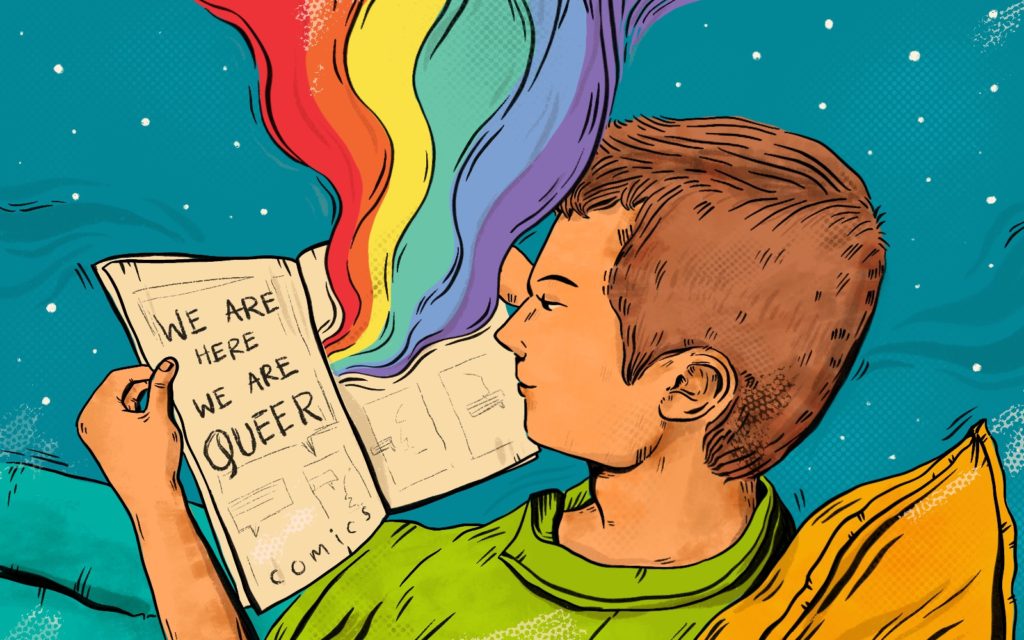On June 28, 1969, New York police raided the Stonewall Inn in the neighbourhood of Greenwich Village. The raid resulted in spontaneous protests and demonstrations from the queer community within the Village that went on until July 3, 1969. This watershed moment gave rise to the queer liberation movement and radicalised the lens through which people viewed queer rights. Unlike most literary theories, queer criticism did not originate within the halls of academia, but from the radical queer liberation movement that gained ground in the wake of the Stonewall Riots. Thereafter queer liberation had two goals – resistance of discrimination and persecution against sexual minorities, and promotion of a sense of pride about one’s sexual identity within the queer community. To achieve these, queer activists employed two main strategies – consciousness-raising, a strategy borrowed from feminist and civil rights movements, and “coming out,” i.e., publicly affirming one’s queer identity. The latter is unique to queer communities whose oppression partly lies in our social invisibility.
It comes as no surprise then that since the 70s, most queer culture has been an attempt at (re)claiming the space in society hitherto denied to us; to bring to fore queer texts, popular culture, and historical narratives that have been invisibilised thus far. Additionally, the movement gave birth to queer theory which delineated existing concepts (and oftentimes coined new ones) of gender, sexuality, social constructs of bodies through a non-heteronormative and non-heterosexist gaze. This exercise in reclamation made up the majority of queer culture and theory until the late 2000s. All texts stemming from the queer movement focused on either explaining queer identity to non-queer folk or coming to terms with one’s own queerness, be it novels or movies, TV shows or magazines, comic books or news. We must understand twentieth-century queer culture not merely as representation, but as a tool to establish a counter-cultural rhetoric that resisted the imagination facilitating homophobic oppression, cultural demonization, and poisonous stereotyping.
Not unexpectedly, and quite justly, anger was one of the main underlying emotions through most of these texts; frustration built up from suffering centuries of first-hand and inherited persecution. Within the literary space in particular, queer texts post 1970 up until the late 2000s mainly focused on the two strategies mentioned previously. They were revisionist versions of history and classical mythology (queer readings of the Trojan war), queer analysis of canonical texts and authors (works of Oscar Wilde and EM Forster), personal memoirs, fictive representations of the difficulties of being queer and the persecution that followed (The Price of Salt by Patricia Highsmith), texts depicting forbidden desires (not always in a favourable light) and confused identities as the main tenets of a character’s narrative arc (The Immoralist by André Gide), and so on.
Traditionally, comic books have been the site where violence and anger have been most effectively depicted. Comic books or graphic narratives are located within a visual rhetoric, which is not merely a documentation of history, but an organic retelling of trauma through memory and thus provide the visual immediacy of horror. Graphic storytelling does away with the need for description by directly showing the characters being affected by a particular situation. The graphic narrative builds on precisely this condition: traumatic situations can only be represented as the absence of speech. It is the un-assimilability of traumatic memory that requires a different and more estranging mode of narration and rhetorical strategy. This is what the graphic form fulfils. Furthermore, because of its popular nature, comic books were, for a long time, shunned from serious study, and are still frowned upon in many academic circles. What better way to offer readers ideas and cultures that have been marginalised than to do it in a form that was also originally marginalised?
Graphic narratives not only provided an entirely new verbal-visual medium for expressing queer culture, but also allowed them to heal some of the trauma for many generations of queer people. They also went a step further to form an entirely new wave of narratives that envisioned an inclusive society built on hope, happiness, acceptance, and freedom. It is this new wave which will be the topic of discussion in this paper. I have chosen four graphic narratives by queer writers whose works signify this new wave of queer comics. I would like to mention two things before we begin in earnest. Firstly, the reason I am not doing an in-depth textual analysis is because I don’t want to rob the readers of the joy of experiencing these books first-hand by giving away all of the spoilers. Secondly, even though the texts that I’ve chosen are vastly inclusive and representational, they do stem from a largely Eurocentric queer comics culture. I’m aware that comics from many Asian countries have a rich history of queer representation, but I am neither that well-versed in the topic, nor can this article afford to expand its investigative ambit to include so much geography. And so, I will limit myself to the following four texts and the queer culture that surrounds them.The texts are – Lumberjanes Issues 1–8 (2014–2020) written and illustrated primarily by Noelle Stevenson, Nimona (2015) by Noelle Stevenson, Taproot (2017) by Keezy Young, and The Tea Dragon Society books (2017–2021) by Kay O’Neill.
Recently, I read a Tumblr post by expobeau that explored the evolution of, and defended, the queer relationships in (primarily) American cartoons. They spoke about how the creators of The Legend of Korra, Adventure Time, and She-Ra and the Princesses of Power (also developed by Noelle Stevenson incidentally. They are quite remarkable!) had to fight tooth and nail with big production houses like Nickelodeon, Cartoon Network, and Netflix so as to surreptitiously sneak in some queer representations since these shows were primarily targeted at children and young adults. The post ended with this: “But don’t fucking dare disrespect any of these other shows by saying they didn’t try, or that their representation didn’t matter. The Owl House is standing on the shoulders of giants. Lumity is only where it is because Korrasami and Bubbline helped get them there.” The point I’m trying to make with these four graphic texts is similar. Their existence would not have been possible were it not for shows like Avatar: The Legend of Korra (2012–2014) and The L Word (2004–2009), or movies like Saving Face (2004) and The Birdcage (1996), or indeed comic books like Alison Bechdel’s Dykes to Watch Out For (1986), and Fun Home: A Family Tragicomic (2006), as also an immeasurable amount of queer fan-fiction that sprouted from a significant lack of queer representation in mainstream heteronormative media. These texts are by no means non-problematic. But they opened up conversations that were until then stigmatised and out of bounds. They awarded agency to the silenced and thus created the space for texts like Lumberjanes, Nimona, Taproot, and The Tea Dragon Society series to emerge and thrive in an environment relatively free from trauma and persecution. In doing so, they marked a stark departure from cisgender heteronormativity by interrogating set definitions through ambiguous, non-normative categories of gender and sexuality. Even so, these texts with positive representations of queer characters form a small percentage of the pop culture younger audiences consume. So it is important to examine and assess their stories.
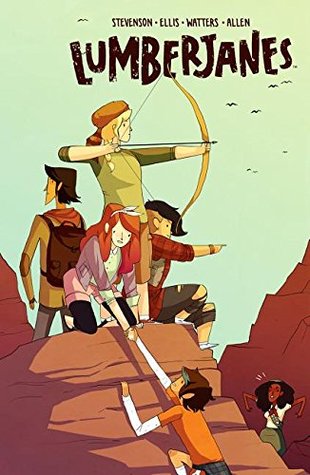
Lumberjanes (2014–2020) is a comic book series consisting of seventy-five issues created by Noelle Stevenson, Grace Ellis, Shannon Watters, and Brooklyn A. Allen. It is set in a summer camp called Miss Quinzella Thiskwin Penniquiqul Thistle Crumpet’s Camp for Hardcore Lady Types and the kids who attend it are called Lumberjane Scouts. The protagonists are five scouts from the Roanoke cabin – Molly, Mal, Jo, April, Ripley, and their cabin leader Jen. The story (at least the first eight issues) deals with the supernatural phenomena and creatures the five scouts encounter and the adventures that ensue. It is a summer camp that from the outset presents an inclusive space for all. Even the presence of the words “lady types” in the name of the camp undercuts set definitions of cisgender femininity and aristocratic echoes of “lady” by affixing “types” so as to posit alternative definitions and subvert gender expectations. The characters themselves are diverse in their depictions. April is portrayed as physically the strongest as well as stereotypically feminine while also having a penchant for puns. Mal is an aspiring punk rock musician and the planner of the group. Jo often leads the group owing to her brilliant analytical skills and also identifies as transgender and non-binary. Molly has a pet raccoon that she wears as a hat and is a tremendous archer. Finally, there is Ripley, who is the youngest of the lot and is looked after by all the others and has the energy of a vigorously shaken bottle of cola.
Lumberjanes explores the interpersonal relationships of their protagonists alongside supernatural adventures and magical interferences. There is a build-up of romantic tension between Mal and Molly that can only be described as wholesome and heart-warming. The main overarching theme that binds all these different threads together is the five Lumberjanes’ strong friendship and their sense of solidarity. Their motto of “Friendship to the Max!” is reinforced throughout the series as the primary bond that strengthens and nurtures the group and makes it possible for them to flourish in their diversity. By expanding the scope of the traditional young adult fantasy narrative to allow for young adult queer relationships as well diverse gender and sexual identities, Lumberjanes holds up a mirror to young readers and gives them the chance to see their own experiences reflected, accepted, and normalised in popular culture.
On the other hand, Noelle Stevenson’s full-length comic book, Nimona, takes place in an entirely alternate universe where medieval fantasy and futuristic science-fiction meld together to form a marvellous anachronism. In addition to the characters, Stevenson also queers time and space. The text is set in the format of, and systematically dismantles, the traditional Arthurian romance. Ballister Blackheart, an erstwhile knight, is now deemed a villain by the Institution of Law Enforcement and Heroics due to his losing an arm, which he replaces with a bionic one. Sir Ambrosius Goldenloin was once Blackheart’s friend and love interest, but now works for the Institution and has become his nemesis. Nimona is a teenage shapeshifter who pesters Blackheart into making her his sidekick in the quest to defeat Goldenloin and take down the Institution. The story follows the typical progression of a medieval romance, but queers it all the way. Stevenson’s characters are quirky and complex, and seek to upend archetypes at every given opportunity. For example, Blackheart has reservations about killing and conniving, while Goldenloin isn’t averse to trickery and tries to kill whenever possible. Through one of the characters, Meredith Blitzmeyer, who is a magical scientist* (*not a witch), Stevenson merges the tropes of the witch and the mad scientist in fantasy and science-fiction respectively. As is tradition, Blitzmeyer operates on the periphery of society and has no stake in its success or downfall.
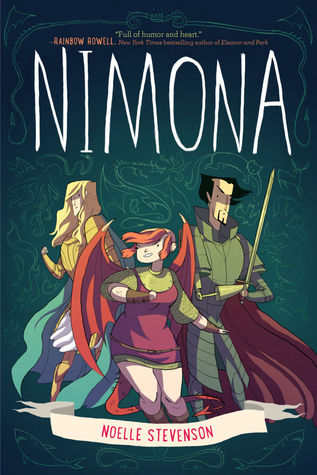
In fact, in making queerness a specific subversion while presenting an alternative to the traditional Arthurian trope, and by turning Nimona into a “monstrosity,” Stevenson effectively transforms all the protagonists of the book into outsiders. As such, they constantly straddle the desire for being accepted within the society in their set roles as hero, villain/antihero, and sidekick, and the reality of being outcasts because of their different queernesses. Mihaela Precup suggests that Stevenson through Nimona’s shapeshifting interrogates the idea of a “monster” as a testing ground for the making and enforcing of normativity. It is a plea for solidarity of the disenfranchised against these forces of normativity through the inclusion and usage of vocabulary and platitudes traditionally employed by the state and society to persecute non-normative individuals, and reclaiming them to display the nefarious and black-hearted nature of institutions that control and persecute.
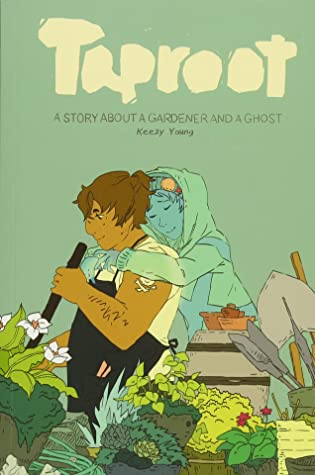
Another comic book that destabilises the traditional romance structure is Taproot by Keezy Young. Simply because it is a romance between a teenage boy and the ghost of another teenage boy. Hamal is a gifted gardener working in a nursery called Takashi’s Flowers. I say gifted because not only does Hamal have a green thumb, but he also has the gift of being able to see and communicate with ghosts. One such ghost is Blue. He is Hamal’s best friend and is hopelessly in love with him. The book’s conflict though is not their love, but a supernatural force that is unsettling the ghostly realm of the inbetweeners and is slowly seeping into the human world. And this is where the book excels. Taproot’s queerness is not accidental or incidental, it is very much intentional. However, it is not foundational. And in not being so, it is successfully inclusive and representational. It also happens to be one of the most beautiful books I’ve ever read.
Kay O’Neill’s The Tea Dragon Society series is another brilliant example of how effortlessly and warmly one can portray representation and inclusion. As the name suggests, the series revolves around tea dragons, who are by far the cutest iterations of the fantasy creatures I have ever come across. Tea dragons are small dragons, about the size of a puppy, whose antlers grow tea leaves that can be harvested and brewed by their caretakers. The happier the tea dragon is, the better the tea will be. The series consists of three books – The Tea Dragon Society (2017), The Tea Dragon Festival (2019), and The Tea Dragon Tapestry (2021). The first book begins with Greta, a young part-goblin part-human blacksmith apprentice, finding a lost tea dragon in the market and taking her to her caretaker, a Sylke bounty hunter and wizard turned tea shop owner called Hesekiel. He lives with his partner, a wheelchair-using human swordsman named Erik. The couple have retired to the outskirts of the town and now spend their time tending to the tea dragons. They have also taken in a part-ruminant prophetess named Minette. Together the four of them form a tea dragon society – a group that seeks to pass down the highly specialised skills needed to tend to tea dragons. The different species of tea dragons are all named after the different types of tea – ginseng, peppermint, rooibos, chamomile, barley, etc. In the second book, The Tea Dragon Festival, we are introduced to Aedhan, an actual dragon who is tasked with the safeguarding of Erik’s home town. He helps a younger Hesekiel and Erik overcome a wayward spirit and restore balance to the village. The second page of the book has a note for the readers. It says, “In this book, characters use both American Sign Language and voice to communicate.” Below this are panels showing how ASL is portrayed within the comic. The third book, The Tea Dragon Tapestry, sees the blossoming of Greta and Minette’s love as well as a solidifying of life goals for all the members of the tea dragon society.
Through the Tea Dragon Society books, O’Neill very beautifully introduces to us the genre of gentle and soft fantasy. Where Nimona exposes violent conflict as an external force maligning and persecuting queer identities, and where Taproot portrays it as otherworldly, the Tea Dragon Society books eschew it completely and gift the readers a fantastical story that is wholesome, visually spectacular, and tremendously inclusive and representational. The book queers the very category of humanness thereby disrupting most tenderly all the preconceived notions of cisgender heteronormative social constructs.
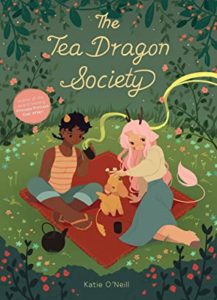
I discovered queer culture when I was about eighteen. I read Kari and watched The L Word and was blown away by how astutely these texts depicted the daily battles that one fought for being non-normative. That recognition sparked a lifelong interest in queer pop culture, especially comic books. Much like any other communal activity, reading a queer comic book (or consuming any queer culture for that matter) isn’t just about reading a comic book. These texts come with their own culture and fandom and reading them allows one to feel a companionship that is kindred because it has been forged through our collective trauma and subsequent healing. The exhilaration one feels when subsumed within a culture where one doesn’t have to tone down their queerness or dial it up is thus extremely liberating. Which is why Erica Gillingham writes that when a reader is confronted with a lack of representation of themselves in culture, the few narratives that do provide some representation become extremely important. The act of consuming this culture becomes an act of self-affirmation. The texts discussed above provide opportunities for young readers to identify with the central characters’ gender and sexuality and foster what Scott McCloud calls an ‘intimacy in closure’ that only the verbal-visual medium of comics can provide.
Cover Art : Paul Reshmi

